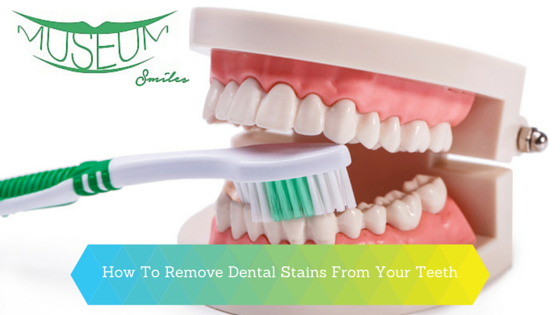Posted: August 10, 2015
 Smiles are contagious! And a smile is a worth a thousand words. It would be great to have bright smile every day. However, diet and habit can stain the pearly whites behind the smile.
Smiles are contagious! And a smile is a worth a thousand words. It would be great to have bright smile every day. However, diet and habit can stain the pearly whites behind the smile.
There are different staining patterns that require a number of methods for removal. Stains are extrinsic or intrinsic. Extrinisic stains can be removed by brushing or a professional cleaning. Extrinsic stains are due to carbonated drinks, teas, coffee, or smoking.
Intrinsic stains (Internal stains that may require bleaching or coverage from veneers). Stains that occur during development or tooth formation are usually intrinsic.
A dental cleaning can remove stains. But they may return if eating and drinking habits are not modified. These may occur from iron deposits on teeth. When there is a considerable amount of plaque and bacteria present, iron can interact with hydrogen sulfide from the bacteria. This results in dental stains that are tenacious in nature. A dentist can identify the pattern of stains to determine if iron is a contributor to dental discoloration. With good brushing and oral irrigation, plaque can be reduced before significant staining occurs.
Some staining occurs before or soon after birth and this is intrinsic. Antibiotics (tetracycline) or an excess of fluoride are common causes of intrinsic staining. Tetracycline staining is greenish-brown or brownish- yellow and occurs if a pregnant woman takes tetracycline or the child takes these antibiotics during a critical stage in dental development. Due to this side effect, Tetracyclines are usually avoided in the treatment of pregnant woman and developing children. Tetracycline staining may require coverage from veneers.
Some people are born with a rare genetic condition that causes enamel to be incomplete leading to a brown line or pitted form. In the case of enamel hypoplasia, a cleaning and whitening will not change the appearance of the teeth. Dental fillings or coverage from veneers may be needed.
There are times when stains are white. People may develop white spots on their teeth due to an excessive fluoride intake known as fluorosis or due to demineralization from acidic beverages. A dentist can identify the difference between white spots that are related to the weakening of teeth in the process of demineralization and fluorosis. Children who eat toothpaste or consume an excessive amount of fluoride may develop fluorosis. The white spots from fluorosis can darken over a period of time. When white spots are due to demineralization, it is important to be proactive in preventing cavities. A dental cavity appears as a stain in early stages.
Let’s identify the spots, treat them, and prevent new stains! Contact Museum Smiles to schedule your next dental cleaning in Fort Worth, Texas!


